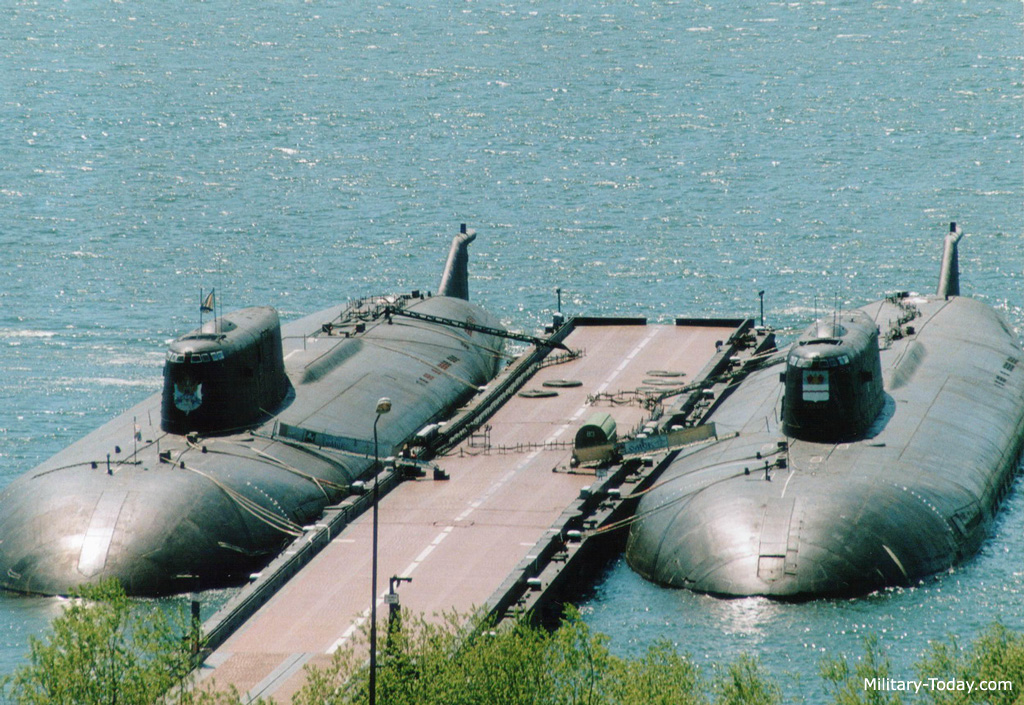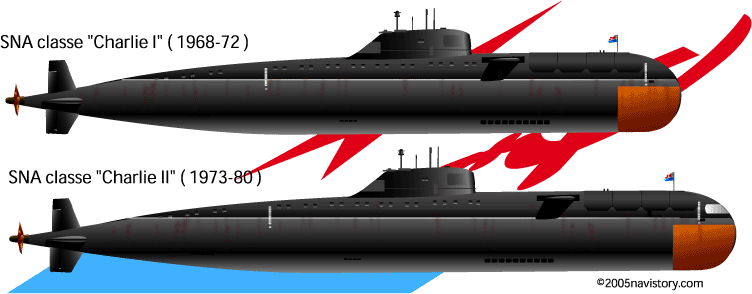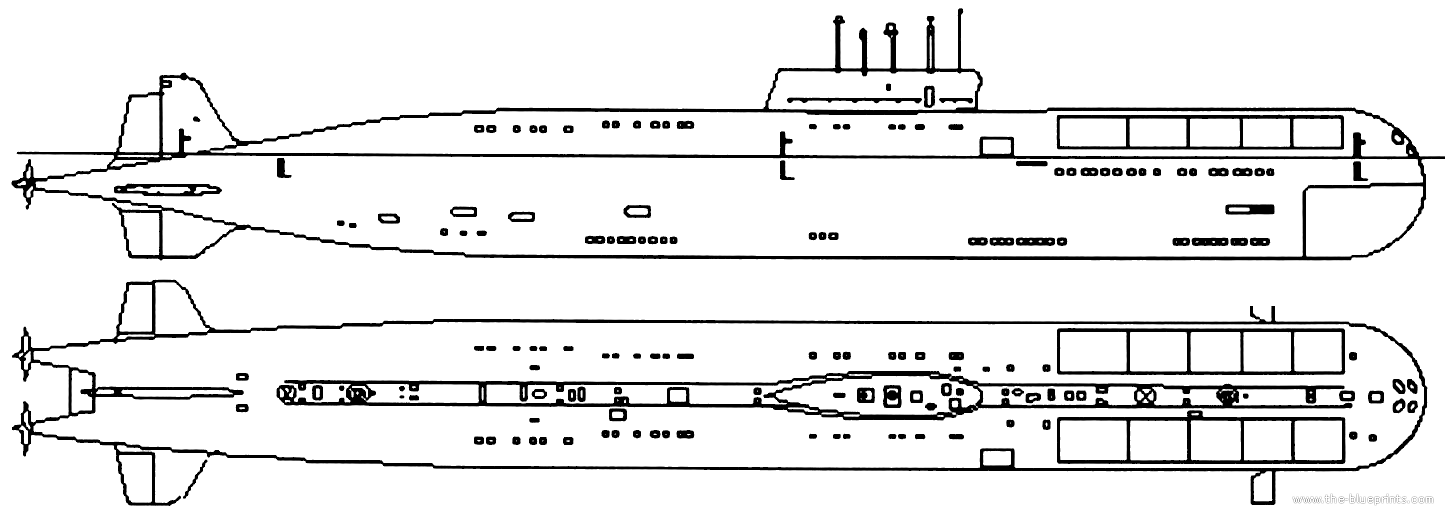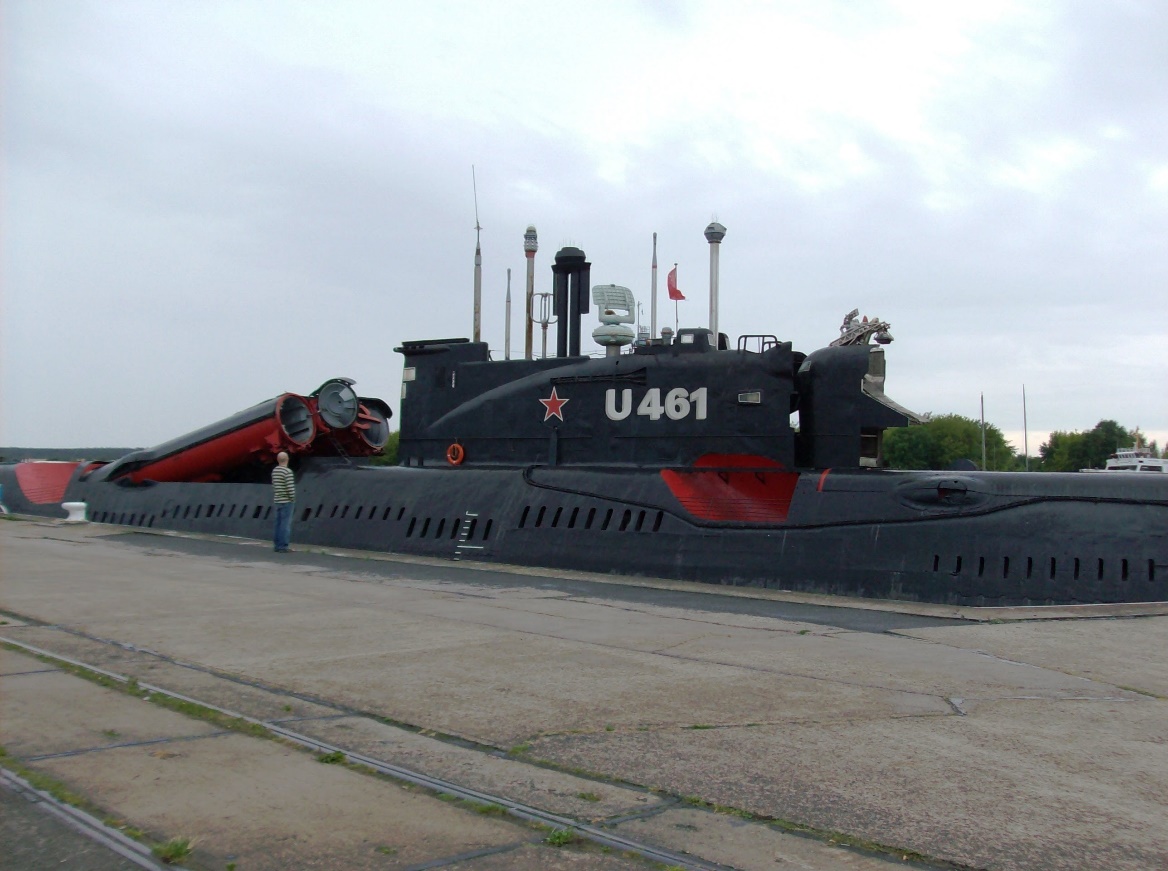Soviet SSG/SSGNs
The Soviet Navy has a long history of using its submarines to deliver guided missiles against both land and naval targets. Guided Missile submarines (SSG) and their nuclear powered counterpart (SSGN) present a complex threat to an adversary. Able to launch their missiles from ranges much greater than most Anti-Submarine Warfare (ASW) defences, these platforms stand a good chance of escaping undetected; while the missiles themselves pose a significant threat they will often trigger defensive measures that might reveal locations or gaps in defences to other lurking threats. Against a weak or isolated foe, the missiles are deadly, but against a well-protected adversary they will often lack the numbers needed to penetrate the defensive screen, unless coordinated with other attacks.
In 1994 these were the largest guided missile submarines in the world (until 2007) and designed specifically to attack US aircraft carrier battle groups. These 18,000 ton boats have, as all Soviet submarines, a double hull, an inner pressure hull and an outer, hydrodynamic hull. In the case of the Oscar, the two hulls are separated by rubber noise dampening material. The two nuclear reactors and steam turbines propel the Oscar at over 30kns, at a maximum depth of over 300 and possibly as much as 600 meters. In addition to torpedoes, the real weapons of this monster are the 24 - SS-N-19 Shipwreck missiles, with a range of 380 nautical miles and a 750Kg (1653 lbs) warhead. There are two versions of the Oscar – the Soviet named ‘Project 949 Granit’, or ‘Oscar I’ with two examples and the ‘Project 949A Antey’ or ‘Oscar II’ which is 10 meters longer, the space allowing for better computing and targeting systems , and much quieter with improved propulsion equipment and a seven blade propeller. Historically there is debate on how many Oscar II’s were planned but it is fairly certain that 11 were launched with the 11th significantly delayed, and three more building and later scrapped. In Northern Fury, the first 11 are in service with three more building and an additional four planned. There were also a bewildering number of name and pennant changes for these boats, the names presented are those used in 1994 as best as can be determined.
| Class | Pennant | Name | Fleet | Remarks |
|---|---|---|---|---|
| Oscar I | K-525 | Arkhangelsk | Northern | |
| K-206 | Murmansk | Northern | ||
| Oscar II | K-148 | Krasnodar | Northern | |
| K-119 | Voronezh | Northern | ||
| K-410 | Smolensk | Northern | ||
| K-266 | Orel | Northern | ||
| K-141 | Kursk | Northern | ||
| K-173 | Krasnoyarsk | Pacific | ||
| K-132 | Irkutsk | Pacific | ||
| K-442 | Chelyabinsk | Pacific | ||
| K-456 | Kasatka | Pacific | ||
| K-198 | Omsk | Northern | ||
| K-512 | Tomsk | Pacific |

Considered a ‘Second Generation’ of Soviet Submarine, the Charlie class has two main variants. The Charlie I is slightly smaller has eight SS-N-7 Starbright while the Charlie II has eight of the much more capable SS-N-9 Siren missiles. Although these boats are much more capable than their predecessors, they have many design flaws, are relatively noisy and can only maintain 24knts speed, insufficient to maintain pace with many of their perspective targets. By 1994, the Charlies are not likely to be used against US aircraft carriers, but will limit their hunting to commercial and logistic traffic, where their lack of stealth, short ranged and limited number of missiles may allow them to survive better.
| Class | Pennant | Name | Fleet | Remarks |
|---|---|---|---|---|
| Charlie I | K-25 | Pacific | ||
| K-43 | Pacific | |||
| K-87 | Pacific | |||
| K-121 | Pacific | |||
| K-313 | Pacific | |||
| K-308 | Pacific | |||
| K-320 | Pacific | |||
| K-302 | Pacific | |||
| K-325 | Pacific | |||
| K-429 | Pacific | Sunk, refloated, sunk again: refloated and in service | ||
| K-201 | Pacific | |||
| Charlie II | K-458 | Northern | ||
| K-452 | Berkut | Northern | ||
| K-479 | Northern | |||
| K-503 | Northern | |||
| K-508 | Northern | |||
| K-209 | Northern |

Papa ClassThis is a single unit class, with the design of submarine K-162 being discouraged from using existing technologies in an effort to spur innovation, development was a long process. Built based on a Charlie class hull as a fast attack submarine with a titanium hull, ten SS-N-7 Starbright missiles mounted forward of the sail and a new reactor set-up; she is considered a forerunner to the Alpha and Siera SSNs, but maintains the designation SSGN. K-162 was the fastest submarine in the world, reaching a speed of 44.7 knts. The sub was placed in reserve in during the late ‘80s and historically was stricken shortly after that – in Northern Fury he remains in reserve and will be recommissioned in the Northern Fleet.

K-162 Papa Class SSGN
 The
Yankee class was the largest class of ballistic missile submarines
(SSBN) ever built, with 34 boats, one of which sank due to a missile
fire. However, they were built in the mid 60’s and the limitations put
on the number of submarine launched ballistic missiles (SLBM) in the
Strategic Arms Limitation Talks (SALT I) treaty meant that as new SSBNs
were produced the older ones needed to be retired. The Soviets felt that
the Yankee class had years of service left in the basic design so they
proceeded to convert many of them: 16 became SSNs (retired by 94), two
became sonar testbed platforms (Yankee Pod and Yankee Big Nose), one was
converted to be a mothership for
the Paltus-class mini-submarines
(Yankee Stretch), one as a testbed for a cancel missile project (Yankee
Sidecar), and four (six planned) were converted to SSGNs – the Yankee
Notch or Grusha class. In Northern Fury all six Yankee Notch were
converted and they each carry 40 conventional or nuclear tipped
SS-N-21.
The
Yankee class was the largest class of ballistic missile submarines
(SSBN) ever built, with 34 boats, one of which sank due to a missile
fire. However, they were built in the mid 60’s and the limitations put
on the number of submarine launched ballistic missiles (SLBM) in the
Strategic Arms Limitation Talks (SALT I) treaty meant that as new SSBNs
were produced the older ones needed to be retired. The Soviets felt that
the Yankee class had years of service left in the basic design so they
proceeded to convert many of them: 16 became SSNs (retired by 94), two
became sonar testbed platforms (Yankee Pod and Yankee Big Nose), one was
converted to be a mothership for
the Paltus-class mini-submarines
(Yankee Stretch), one as a testbed for a cancel missile project (Yankee
Sidecar), and four (six planned) were converted to SSGNs – the Yankee
Notch or Grusha class. In Northern Fury all six Yankee Notch were
converted and they each carry 40 conventional or nuclear tipped
SS-N-21.
| Class | Pennant | Name | Fleet | Remarks |
|---|---|---|---|---|
| Yankee Notch | K-253 | Pacific | ||
| K-395 | Pacific | |||
| K-408 | Northern | |||
| K-411 | Northern | |||
| K-252 | Northern | |||
| K-389 | Northern |
These obsolete and accident prone boats are considered ‘First Generation’ SSGNs. The preceding Echo I class were all retired by 1994 but all surviving Echo IIs remain active in the Northern Fury campaign. These boats must surface to launch their missiles, and must remain in that vulnerable state until the missiles receive mid-course guidance updates – up to 20 minutes. Modern submariners would consider this as suicidal. These boats have gone through a series of upgrades to carry more modern missiles, the original boats carried eight SS-N-3a "Shaddock" anti-ship missiles, 14 were converted to carry the P-500 Bazalt SS-N-12 "Sandbox", and of five of these (3 historically) were converted to the improved P-1000 version with a better radar and extended range. Of the 29 boats, one has been sunk in a collision but there have been 13 major collisions, fires, or reactor accidents involving these boats. Three boats had been converted to receive targeting data directly from satellites, and historically, one of the boats was converted to support divers and Special Forces, in Northern Fury four of the original boats have undergone this conversion.

| Class | Pennant | Name | Fleet | SSM | Remarks |
|---|---|---|---|---|---|
| Echo II ST | K-1 | Northern | Sat Tgt | ||
| Echo II M | K-127 | Northern | P-500 | ||
| K-10 | Sunk in collision, 1982 | ||||
| Echo II ST | K-22 | Krasnovardeets | Northern | Sat Tgt | |
| K-23 | Pacific | ||||
| Echo II M | K-428 | Pacific | P-500 | ||
| K-431 | Northern | Reactor accident, Reserve | |||
| Echo II M | K-134 | Kefal | Northern | P-500 | |
| Echo II ST | K-35 | Northern | Sat Tgt | ||
| Echo II SOF | K-47 | Northern | SOF | ||
| Echo II MKV | K-48 | Northern | P-1000 | ||
| K-56 | Pacific | ||||
| Echo II M | K-557 | Northern | P-500 | ||
| Echo II MKV | K-74 | Northern | P-1000 | ||
| Echo II SOF | K-86 | Northern | SOF | ||
| Echo II M | K-90 | Pacific | P-500 | ||
| Echo II SOF | K-94 | Pacific | SOF | ||
| Echo II M | K-144 | Pacific | P-500 | ||
| Echo II MKV | K-108 | Northern | P-1000 | ||
| K-116 | Pacific | Reactor accident, Reserve | |||
| Echo II M | K-125 | Northern | P-500 | ||
| Echo II MKV | K-128 | Pacific | P-1000 | ||
| Echo II M | K-135 | Northern | P-500 | ||
| Echo II SOF | K-166 | Pacific | SOF | ||
| Echo II M | K-172 | Northern | P-500 | ||
| K-175 | Pacific | ||||
| Echo II MKV | K-184 | Pacific | P-1000 | ||
| K-189 | Pacific | ||||
| K-192 | Pacific | Reactor accident, Reserve |
Juliett Class SSG
This class of 16 conventionally powered boats are the only SSG remaining in service, all of the Whiskey class conversions have been retired. Built to compensate for the slow design and construction of the Echo I and II classes, the Julietts are well past their prime and historically were all stricken between 1991 and 1994. They are able to fire Four SS-N-3 Shaddock (P-6) from the surface only.
| Class | Pennant | Name | Fleet | Remarks |
|---|---|---|---|---|
| Juliett | K-156 | Northern | ||
| K-85 | Baltic | |||
| K-70 | Pacific | |||
| K-24 | Baltic | |||
| K-77 | Baltic | |||
| K-81 | Baltic | |||
| K-68 | Baltic | |||
| K-63 | Pacific | |||
| K-58 | Northern | |||
| K-73 | Pacific | |||
| K-67 | Black Sea | |||
| K-78 | Baltic | |||
| K-203 | Baltic | |||
| K-304 | Northern | |||
| K-318 | Black Sea | |||
| K-120 | Pacific |
